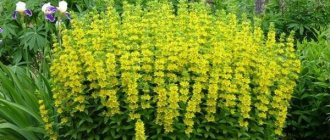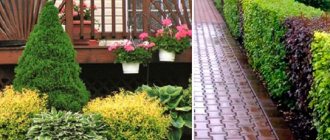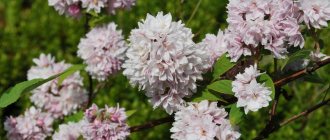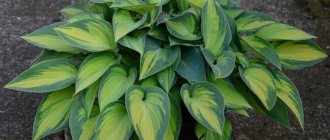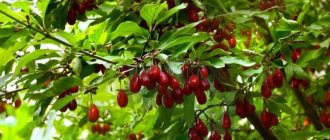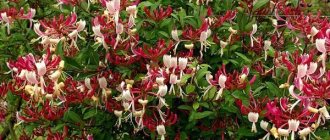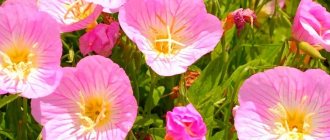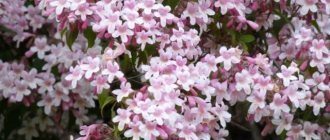Preparing for landing
Successful cultivation of weigela begins with proper planting and preparation for it. This section provides recommendations for choosing a seedling, place and timing of planting, landscape design and soil.
Selection of seedlings
We recommend purchasing three-year-old seedlings from nurseries or garden centers located in your climate zone. Such plants are well adapted to local weather conditions and take root better in a new location.
We also recommend buying seedlings in shipping containers (TCS), especially for beginners. They are usually sold at garden centers and nurseries. When ordering online, plants are usually sent bare-rooted in peat and packaged in film. For many gardeners, this is the only opportunity to purchase an original and unusual variety in their region.
- It is better to keep purchased bushes in the apartment as little as possible and plant them quickly in the garden to reduce stress after replanting.
When is the best time to plant?
The Flower Festival magazine believes that it is better to plant weigela in the spring than in the fall, especially with an open root system. Unfortunately, after fall planting, it is not uncommon to see a lot of mortality, especially for plants grown in warmer areas.
But do not despair, we will further tell you how to increase the chances of successful rooting of a seedling when planting in the fall.
Spring
The optimal time for planting a seedling with an open root system in the spring: as soon as the ground has thawed and you can dig a hole for planting (40-50 cm). For the Leningrad region and Moscow region, approximately the beginning is mid-April.
Plant seedlings in shipping containers (TCS) after the end of return frosts (late April - mid-May) and before the beginning of summer. Before the onset of hot and dry weather, when during the day the temperature is consistently above +20º. In this case, it is necessary to more carefully cover the plant from sunlight and water regularly.
Depending on the climate of the region, the final planting date will differ. For example, in the Moscow region it is often rainy and cool in June, but in the Krasnodar Territory it is already hot in mid-May. Therefore, be guided by the weather and follow our recommendations.
Autumn
In the fall it is very important to plant at the right time. This must be done 30-40 days before the onset of stable cold weather. In extreme cases, at least 15-20 days. Approximate planting dates: Moscow region - ideally the beginning is mid-September, but it is possible at the end of September.
When planting in autumn, the chances of successful rooting are higher for a seedling with a closed root system. The fact is that in some nurseries they dig up the plant they like when purchasing it, but in this case the root system is damaged and it is riskier to plant such a seedling in the fall than in the spring.
In addition to the right time of planting, it is also important to prepare the bush well for wintering. According to reviews from flower growers, now acclimatized seedlings take root better when planted in the fall than 5-7 years ago. Apparently the quality of planting material in nurseries has improved.
As a gardener from the north of the Leningrad region reports: “I planted Weigela in mid-September, mulched the tree trunk well and made a well from branches around the bush about 20 cm high for protection from the wind (a plot in the field). It took off, there was little growth in the first year, but the next summer it grew well.”
A gardener from the Yaroslavl region also shares his experience: “At the end of September, I planted a ZKS seedling, spread hay on the ground around the bush and that’s it. The bush looks great after two years. I prefer to plant shrubs and trees in the fall, because there is no bright sun, there is enough moisture, and I come to the dacha only on weekends, and everything is well received.”
Therefore, after planting a shrub in the fall, be sure to add a 5-7 cm layer of mulch (compost, humus, leaves, hay, sawdust) and make a shelter for protection from the wind.
By the way, gardeners of the old school used to do this: in the fall they buried the seedling at an angle to cover most of the crown with soil, and in the spring they planted the weigela in a permanent place.
What to do if you didn’t have time to plant in the fall?
If you have already bought a seedling, but frost is predicted in the next 2-3 weeks, then you don’t have to risk it and take it indoors for the winter. Water the weigela in a pot very moderately before it sheds its leaves, and then move it to a cool place (+1-6º) on a balcony or loggia.
Until spring, water even less often, but the main thing is not to let the earth clod dry out completely. Until January-February, a seedling grown in a garden or nursery will be dormant.
Weigela will begin to wake up closer to spring, and sprouts will appear. This usually happens earlier than in nature. Now water a little more often, but moderately. In winter, the pot does not need to be placed in a well-lit place, but after sprouts appear, it must be moved to a bright place.
Then transplant the seedling into open ground after the end of return frosts according to the general instructions.
Transfer
It is also better to replant weigela in April, before the leaves bloom, while the root system is still dormant. Plants up to 5-6 years old tolerate transplantation better than older specimens. But for them, replanting may be the only chance for the bush to freeze less in winter and bloom in summer.
Landing location
Weigela is a light-loving plant, and it develops best and blooms profusely in a well-lit place. A bright sunny place should be protected from drafts and strong winds so that its flowers and leaves are not damaged by them. The north wind is especially dangerous. Species with white edging on the leaves are more light-loving.
Most species can grow well in light partial shade if they are planted near trees with a sparse crown. In dense shade, the shrub develops much more slowly and blooms weaker. Its seeds take longer to ripen and its shoots become lignified.
If you plan to plant near a house or building, then plant on the south side.
Weigela bush for the second year after planting in a good place from a seedling with ACS (1 stem with roots)
Landscape design
Weigela can be used in a variety of ways in the garden. It is indispensable for setting up a Japanese-style garden. Tall species and varieties are convenient to use as hedges. Low-growing varieties will easily decorate rocky areas and alpine hills.
The shrub looks great as a single planting at the edge of the forest, as a curtain on the lawn, at the gate or at the front entrance on the ground lawn. You can also get a spectacular combination if you plant it under sparse trees with an openwork crown.
Weigela is also great for group plantings. It is recommended to use only one species or variety in one group and plant no more than 3-5 specimens in the middle of an emerald lawn. Ornamental shrubs should be harmoniously combined in their shape and size, flowering period and flower color.
For plants planted in groups, it is better to make a common circle around the trunk with a 2-4 cm layer of mulch. In rare group plantings, we recommend filling the space between the weigels with perennial flowers: astilbes, heucheras, ferns or hostas. They remain decorative until autumn.
Weigela goes well next to other shrubs and in mixed plantings. Harmonious neighbors: low-growing barberry, viburnum "Buldenezh", cotoneaster, lilac, spirea Arguta and Vangutta, mock orange, Japanese quince, as well as conifers - cypress, juniper.
The soil
The plant is demanding on soil. Loves loose, fertile soil without stagnant water, but quite moisture-intensive with a neutral or slightly alkaline reaction. To successfully grow weigela, we recommend preparing the following soil mixture: humus or leaf soil, sand, turf soil - 2:2:1.
At the same time, for some gardeners, the shrub grows in poor soil, but in a bright place protected from the wind, and it develops and blooms well. So there are exceptions to this rule in practice.
What is important to know about autumn planting of weigela
Ornamental shrubs that are planted in the spring, during the period from the soil warming up to the swelling of the buds, take root best. Seedlings planted in autumn most often die in the first winter, which is due to the botanical characteristics of the heat-loving ornamental plant. For planting, you need to choose a place on a hill , protected from the cold northern wind and strong drafts, which cause flowers and buds to fall off.
The south side of the house with good sunlight is optimal for planting and growing. To obtain abundant and long-lasting flowering, the soil on the site must be loose and rich in humus. Preference should be given to sandy or loamy soils that have a slightly alkaline or neutral reaction. It is important to remember that only plants at least three to four years old are suitable for planting.
Before planting seedlings, high-quality drainage must be laid in pre-prepared planting holes. Optimal for planting are holes with dimensions of 50x50 cm and a depth of approximately 35-40 cm in depth. Brick or gravel 15 cm high is laid at the bottom. To fill the holes, garden soil is used with the addition of 40 g of potassium salt and 60 g of superphosphate. The trunk circles of planted plants are mulched with crushed bark or sawdust. An ornamental crop planted in this way quickly takes root and delights with abundant flowering.
How to plant correctly?
- Dig a planting hole 40-60 cm deep and wide, depending on the size of the seedling. At the bottom of the pit, it is advisable to make drainage with a layer of 8-10 cm of sand and gravel (fine crushed stone, broken brick) - 1:1. On clay and heavy soil, drainage is mandatory.
- Place the weigela in the hole so that the root collar is at ground level or no lower than 1-2 cm.
- Fill the voids with soil or prepared soil mixture, gradually compacting it.
- Water the bush generously with water and protect it from the sun. To do this, you can drive stakes and cover them with non-woven material (agrofibre, spunbond, lutrasil), or, in extreme cases, a piece of cotton fabric, curtain, gauze.
Adviсe
- The distance when planting between bushes of tall species (height up to 2.5 m) is at least 1.5-2 m, and ideally 2.5-3 m. For most varieties in our conditions, 80-100 cm is sufficient.
- It is recommended to dig up the soil 2-3 weeks before planting, ideally together with compost or humus.
- Plant the shrub in the evening or in cloudy weather for better rooting.
Weigela varieties
In total there are about 15 species of weigela . Most of them are found in the East and Southeast Asia. For our natural conditions, the following frost-resistant varieties are of great importance:
- Weigela praecox (early or pleasant). The flowers of the early Weigela variety are collected in inflorescences. Each inflorescence consists of 2–3 flowers. Weigela rosea has flowers that are bright pink on the outside and yellowish-white on the inside. The height of the bush is about 2 meters. This variety blooms in early May and continues to bloom for the whole month. In nature it can be found in the Far East. Its distinctive feature is variegated leaves. The green leaves are strewn with yellow spots, which change color to a creamy shade in summer.
- Weigela m >Where to plant weigela
The best time to plant weigela is spring, when the buds swell and the earth begins to warm up.
If you plant seedlings in the fall, they will not have time to take root and will die in the first winter.
When buying a plant, you should check its age. Bushes over three years old adapt more easily to new conditions.
- Choosing a location . It is recommended to plant the shrub on the south side. To prevent flowers and buds from scattering from strong winds, choose a planting site on a hill, but without drafts.
- Lighting . The plant loves a lot of sun. With good lighting, it will begin to develop correctly and abundant and bright flowers will appear on the bush.
- The soil . All plant varieties love loose (sandy or loamy), slightly alkaline or humus-enriched soil. Slightly acidic peaty soil is not suitable for them, with the exception of Middendorf weigela. This plant variety can take root well in such soil.
Planting in open ground
When you have chosen a place for the plant, you can start planting:
- We dig a hole in the ground up to 40 cm deep. If the soil needs to be enriched with fertilizer, then dig a larger hole.
- The first layer is laid in it - drainage. You can use gravel or broken bricks as drainage.
- The second layer is fertilizer. The nutrient mixture is placed under each plant (100 grams of nitrophoska and 0.5 liters of compost). If you treat the roots of seedlings with a substance that stimulates root formation, their chances of survival will increase several times. Radifarm or Viva+ are used as growth stimulants.
- The distance between seedlings of low varieties (up to 1 meter in height) should be about 80 cm. For varieties with a height of 1–2.5 meters, leave a gap of 1.5–2 meters.
- To prevent voids from forming around the roots when planting the plant, the roots should be straightened and compacted well.
- When the earth settles, the root collar of the plant should be flush with the surface of the earth.
- When the work of planting the seedlings is completed, they are thoroughly watered.
- Then the entire area is mulched.
Outdoor care
Weigela is considered an unpretentious plant that is not difficult to care for, but loves attention. According to some gardeners, it is easier to care for than roses, and during flowering the shrub looks no less impressive.
If you planted it correctly in a good place and in a suitable soil mixture, then in the future it will be much easier to grow a beautiful bush. Agricultural cultivation techniques consist mainly of watering, fertilizing, preparing for winter and pruning in spring and summer.
Watering
In spring, weigela is watered depending on weather conditions and how it survived the winter. If after winter the shoots are severely frozen or there was little snow, and in the spring there is little rain and the soil is dry, then you need to water more often and more.
The irrigation rate per bush is 8-10 liters of water, and the frequency is from once every 3-4 days to once every 8-12 days, depending on the listed conditions.
Young bushes, especially in hot and dry weather, are more in need of sufficient moisture. Therefore, water them more often, especially the first 2-3 years after planting or until 5-6 years of age if you grow them from cuttings.
Loosening
After each watering or heavy rain, it is advisable to loosen the tree trunk circle to a depth of 5-8 cm so that oxygen penetrates to the root system.
Weeds also need to be removed periodically. In addition, in some specimens, stem shoots grow in large quantities, which have to be dealt with.
Mulching
It is advisable to mulch the tree trunk circle with sawdust, pieces of pine bark, shavings, peat or small pebbles 4-6 cm thick. It is best to mulch after the soil has already warmed up well, but is still quite moist: from mid-April to mid-May.
Top dressing
It is advisable to carry out the first feeding in early spring in the snow in order to improve the condition of the bush after winter frosts. For this, complex mineral fertilizer is used: nitrogen (urea), potassium, phosphorus (superphosphate) - 20, 10, 10 grams per 1 m².
The second time you need to feed the weigela for abundant flowering, when flower buds are laid (late May - early June). Potassium-phosphorus fertilizer, for example potassium sulfate and double superphosphate - 30 grams for each adult bush or per 1 m².
You can also use liquid complex fertilizer for flowering plants, in which the proportion of nitrogen is lower than potassium and phosphorus.
Attention! The Flower Festival magazine warns that the second feeding should not be carried out later than mid-to-late July, so that the young shoots finish growing and have time to become lignified. There is also no need to feed in the fall.
REFRESH YOUR KNOWLEDGE:
- TYPES OF FERTILIZERS AND THEIR APPLICATION!
- 20 BEST NATURAL FOOD FOR HOUSEPLANTS!
How to transplant weigela to another place
If there is a need to transplant weigela, you must act very carefully and with great caution, since an adult plant does not take root well in a new place. A transplant is justified if the initial location was chosen incorrectly and there is no way to improve the situation in less radical ways.
When is the best time to replant weigela?
Just as in the case of planting cuttings in open ground, it is recommended to replant an adult plant in April, when the soil has already thawed and the growing season has not yet begun. Transplanting weigela in the fall is extremely undesirable, since in this case its fragile root system will not have time to adapt to the new location before the onset of winter cold.
Selecting a location and preparing the soil for weigela
The place for transplanting weigels is selected according to the same criteria as for planting new plants:
- plenty of sunlight and protection from cold winds;
- lack of stagnation of moisture in the soil;
- light fertile soil.
Bloom
In the middle zone and Moscow region, weigels usually bloom from late May - mid-June to early - late July, depending on the type and variety. In warmer regions they may bloom in mid-May. To prolong flowering, it is important to water the bushes in a timely manner, since flowers fade faster in overdried soil.
The great advantage of the plant is its tendency to remontant. The shrub blooms for the second time this season on the tops of young shoots. Flowering usually begins in August and continues until the first autumn frosts, and sometimes even after them.
Often the first flowering smoothly flows into a second one and it turns out that the shrub blooms all summer and until late autumn. The second time, the flowering is, of course, less lush and the closer to winter, the fewer flowers there are, but still, they lift the spirits on the cloudy days of September and October.
For example, in 2011, a gardener we know from the Moscow region had weigela blooming even in early November, withstanding cold nights and retaining 7-8 branches with buds and flowers.
Attention! We advise cutting off the first buds of young plants in their life for better development of the crown and bush as a whole.
Why doesn't it bloom?
In this matter, it is important to know: are you waiting for flowering for the first time or the bush was blooming before, but has now stopped. Therefore, think about which of the listed possible reasons for the lack of flowering is close to your situation.
- Adaptation to a new place. If less than a year has passed since the seedling you purchased was planted, then most likely it has not yet adapted to the new place. Planting is a serious stress for the plant. During the first summer, it just begins to get used to the new growing conditions, and the roots master the soil. Therefore, for now, properly care for the shrub, and next year it will delight you with the first flowers.
- Age of the bush. Weigela grown from seeds begins to bloom from the fourth year of life, and those grown from cuttings bloom earlier: strong specimens in the second year, and weaker ones in 3-4 years. Therefore, perhaps your plant is still young. Nurseries mainly sell 30-50 cm 2-3 year old bushes. The opposite reason is that the bush is too old.
- Adult weigela most often does not bloom due to lack of sunlight, water or severe frosting in winter. Analyze these aspects, in 99% of cases the reason is precisely in them.
Description and growth conditions of weigela
Weigela is included in the genus of shrubs of the Honeysuckle family (Caprifoliaceae). It is a moisture-loving and conditionally shade-tolerant, deciduous, erect shrub. It has such advantages as: elegance, ease of reproduction and care.
The plant received its name in honor of the German chemist, botanist and pharmacist Christian Ehrenfried von Weigel. In the wild, weigela is found in the Far East of Russia and East Asia. The genus includes 15 species. Typically, 7 species and about 10 varieties are cultivated, which are distinguished by their high decorative value.
How to deal with pests?
A characteristic quality of weigela is flowering. Namely, it can bloom twice in one growing season. The flowers bloom for the first time in late spring and early summer. Flowering is abundant, the flowers are funnel-shaped, bell-shaped, solitary or one to six on last year's shoots, in the axils of the upper leaves. The next one is in late summer-early autumn on this year’s shoots, less lush.
Flowers can range from milky, pink to amaranth and carmine red. It happens that during the flowering process, a flower changes shade from light to dark, intense. Flowering lasts 3-4 weeks. The fruits are capsules with small, often winged seeds.
Trimming
Weigela needs annual sanitary pruning in the spring and formative pruning every 2-3 years in the summer to give the bush a more decorative shape.
Sanitary pruning
No matter how well we cover the weigela for the winter, its branches often freeze from frost. In the same area of the Moscow region, in most cases, only bushes growing in Moscow and in very favorable places in the Moscow region do not suffer.
Therefore, every spring, be sure to check how the bush overwintered and, if necessary, prune branches damaged by frost. You need to cut off the tops of frozen shoots to healthy tissue (living bud).
Therefore, pruning in spring is purely individual. Some shoots do not need to be cut off at all, while others have only the tips or 8-10 cm, or even 15-20 cm or more. If one of the main shoots freezes, it is better not to cut it off completely, but leave 10-15 cm from the ground - in case a bud near the root survives and it will move away. Sometimes shoots break under the weight of snow or become too frail, then they are removed too.
It is best to prune in April, and in addition to frost-damaged shoots, you also need to remove old, diseased and dry branches.
- If there were no frostbitten shoots, then sanitary pruning can be combined with formative pruning. Those. remove old flower branches after flowering.
Formative pruning
It is enough to carry out formative pruning once every 2-3 years to give it a more decorative shape (compactness) and better flowering. The best time to prune weigela is immediately after the first flowering (mid-late July), so that new branches have time to grow and ripen over the summer, which will bloom profusely next year.
The shrub can be given different shapes. In the middle zone, it rarely reaches a height of more than 1.5 meters. Some gardeners do not allow it to grow above one meter (80-90 cm), trim it every year by 10-15 cm and try to give it a ball shape. Others leave 2-3 main shoots, which are cut off when they become 100-120 cm in height.
Therefore, it all depends on your desire.
Young bushes
In young bushes, in the first three years after planting, it is recommended to shorten all shoots by half their length in order to first strengthen and develop the root system well.
Then every year it is enough to remove old flower shoots and branches from such a bush. And after flowering, carry out formative and corrective pruning: all vigorous vegetative shoots (those that do not bloom) are shortened within the crown of the bush.
If a young plant has not formed correctly or you are not satisfied with its appearance, then you can cut off all its shoots to stumps 15-20 cm high. Since in all types of plants the bush grows due to tillering from the root collar, you have the opportunity to get the desired appearance again view.
Cuttings
For cuttings in the second year of life, you can shorten the tops of the shoots by 10-15 cm for better tillering and a more luxuriant shape. After a few weeks, the dormant buds wake up and young shoots grow, which will create a voluminous shape.
old bush
Over time, the bush ages and becomes less decorative and blooms weaker. In this case, you can take a chance and also trim to a “high stump” - remove all shoots at a level of 15-20 cm from the ground. Such “reanimating” pruning of an old, but beloved and dear bush can breathe a second life into it.
However, know that you need to be very careful when pruning an old weigela bush that has never been trimmed before. Experts advise cutting only the oldest branches and only after flowering, since the plant may not tolerate severe pruning and will wither.
Ideally, each cut for all types of pruning should be made with a clean pruning shears after dipping a rich pink-violet potassium permanganate solution. We recommend powdering the cut areas with crushed activated carbon or treating them with garden pitch or special garden antiseptic paint. As a last resort, smear the wounds with at least green paint.
Weigela care
Spring care
Growing weigela is not labor-intensive, and you will definitely cope with it. Spring planting is completed, and now all you have to do is care for the weigela in accordance with the rules of agricultural technology: water moderately during the dry period (if the area is mulched, you will not need frequent watering), remove weeds as they appear and be careful not to damage roots of the bush, loosen the soil to the depth of a spade bayonet.
Caring for weigela also includes the application of nutritional fertilizers, but if during planting you added compost and nitrophoska under the roots, then you can not fertilize the weigela for two years. In the third year, in early spring, in order to stimulate the growth of new shoots and leaves, apply a complete mineral fertilizer to the soil - ammophoska, diammofoska, Kemira-lux or other fertilizer containing phosphorus, potassium and nitrogen.
- Tips for caring for cineraria (video)
The second time, at the end of May or beginning of June, when the weigela forms buds, apply a second feeding consisting of potassium and phosphorus fertilizers (superphosphate, potassium sulfate), which will ensure longer and more luxuriant flowering, and at the same time strengthen the branches of the plant for winter.
The third fertilizing is carried out during autumn digging - wood ash is added at the rate of 200 grams per square meter of land or Kemira fertilizer - autumn in the dosage specified in the instructions.
Blooming bush
The most remarkable advantage of weigela over other garden shrubs is that it blooms twice per season: the first, very abundant flowering occurs on last year's shoots from mid-May to mid-June, the second time, but not so luxuriantly, weigela blooms in August-September on the shoots of the current year. Blooming weigela is a delightful sight.
Weigela propagation
Weigela is easily propagated by seeds, but since seed germination lasts only for one or two years, there is no point in going to the trouble of sowing seeds in boxes and greenhouses. Moreover, it is much easier to leave the seeds that have sprouted in the fall in the ground, and in the spring, when they germinate, leave the strongest seedlings and grow them for two years until the time comes to transplant them to a permanent place. However, it should be remembered that during seed propagation, the species properties of plants may not be preserved, so flower growers prefer vegetative propagation methods to seed propagation: summer green or last year’s semi-lignified cuttings, young shoots from a stump or layering.
Cuttings 10-15 cm long are cut from green shoots of the current year, cut at the end of June, or semi-lignified shoots from last year, cut in early spring before the sap begins to flow, as well as from basal shoots, the lower leaves are removed from them, and the upper leaves are shortened by half. The lower cut of the cuttings is treated with Kornevin, then the cuttings are planted in a mixture of sand and peat, covered with a four-centimeter layer of sand. Planting cuttings should not be deep; a depth of one centimeter is sufficient. Each cutting is covered on top with a glass jar or cut plastic bottle, which is removed daily to ventilate and moisten the cuttings. As soon as you find new shoots on a cutting, pinch it back to encourage tillering.
They propagate by layering like this: one of the lowest shoots is bent to the ground, in the place where it comes into contact with the ground, the bark of the layer is slightly damaged, attached to the ground and sprinkled with soil. Next spring you will have a full-fledged weigela seedling. Please note that both cuttings and layering must be grown for three years before planting in a permanent place.
Trimming
Like any shrub, weigela needs pruning. Young bushes only need sanitary pruning, in which broken, frozen, diseased or thickening branches are removed in early spring. Mature bushes are subjected to formative pruning, which is carried out in mid-summer after the first flowering of weigela, while new shoots have not yet grown. But keep in mind that the second flowering occurs precisely on the shoots of the current year, so if you missed the time for summer pruning and the shoots began to grow, it is better not to carry out summer pruning at all.
- Crocosmia: planting and care, growing from seeds
In addition, adult bushes need rejuvenating pruning every three to four years, during which all branches that are more than three years old are removed, and the rest are shortened by a third. Sometimes it makes sense to cut off all the shoots, and don’t worry, weigela recovers well after such pruning.
Pests and diseases
Most often, weigela is attacked by aphids and leaf-eating caterpillars, and in extreme heat - by spider mites and thrips, but usually by the time the heat sets in, the first flowering of weigela is already coming to an end. To control pests, they use Rogor, Nitrafen, Keltan - pesticides that harm the environment. To avoid this, it is better to use insecticidal plant infusions, for example, from wormwood, hot pepper or garlic, to destroy pests.
If the seedlings begin to turn yellow and wither after planting, it is quite possible that their root system was affected by the larvae of the cockchafer or mole cricket, which could have been brought into the planting hole with humus or compost. In this case, spill the soil with a solution of Karbofos or Aktara.
Diseases that pose a danger to weigela include rust, gray rot and spotting. To combat bacterial and fungal diseases, treatment with Bordeaux mixture is used - milk of lime with copper sulfate. In order to prevent diseases, it is advisable to treat weigela during the period of leaf appearance with a three percent Topsin solution.
Diseases and pests
The shrub rarely gets sick or is affected by pests. Leaves and leaf axils can be infested by aphids. We have a good article about fighting it: HOW TO GET RID OF APHIDS?
Also see: THE MOST COMMON PESTS!
Sometimes leaves can be affected by bacterial diseases. If they fall off prematurely, there are yellowish or purple spots or a white coating on top, then immediately after detecting symptoms, spray the bush with Bordeaux mixture.
“Topsin” can help deal with rot and rusty spots: before buds open, use a 3% solution, and after – 1%.
Attention! The Flower Festival magazine warns that it is not always easy even for a specialist to accurately determine the disease. Therefore, try to consult with experts or experienced gardeners as soon as possible.
Weigela shrub - description
Weigela is a beautifully flowering erect deciduous shrub with opposite leaf arrangement, mostly petiolate, but sometimes almost sessile serrate or serrate-toothed leaves without stipules and axillary pink, yellowish, dark red, purple, cream or white almost sessile flowers up to 5 cm long, sometimes solitary, and sometimes collected in inflorescences of six or more pieces. The calyx of the flower has five separate or united lobes at the bottom, a bilipped or zygomorphic corolla, funnel-shaped or tubular-bell-shaped. The tube is significantly longer than the corolla blades. The bush usually begins to bloom at the end of May or early June and lasts about a month. With good care and properly selected growing conditions, weigela blooms again at the end of summer, although not so abundantly and for a long time. The color of weigela flowers at the end of flowering is much more intense than at the beginning.
The fruit of weigela is a cartilaginous or woody bivalve capsule of cylindrical or ellipsoidal shape, filled with small, angular, often winged seeds.
Reproduction
Weigela can be propagated by seeds and vegetatively. Advantages of seed propagation: the ability to obtain a large number of seedlings, plants grow more viable and resistant to adverse weather conditions, and are also better adapted to the local climate.
The disadvantages include: long development (they bloom in the fourth year), high labor intensity and the impossibility of preserving all varietal characteristics. In addition, complete seed ripening is possible only in the south of Russia, and in colder regions there is much less chance of obtaining them.
Therefore, if you want to propagate a specific variety, then you need to use vegetative propagation methods: cuttings, dividing the bush and layering. The shrub can be propagated in spring (winter cuttings) and summer (summer or green cuttings).
- For more details, see the appendices to the article.
Monthly care calendar
| April | Sanitary pruning. Transplanting and planting bushes. Abundant watering. First feeding. Propagation by winter cuttings. |
| May | Planting seedlings. Abundant watering. Weeding from weeds, shoots and loosening, and mulching of the tree trunk circle. |
| June | Watering. Second feeding. Weeding and loosening. Propagation by green cuttings. |
| July | Formative pruning after flowering. Watering, weeding and loosening. |
| August | Watering, weeding and loosening. |
| September | Planting, transplanting. Watering, weeding and loosening. Mulching the tree trunk circle with a 5-7 cm layer of foliage, sawdust or peat. |
| October November | Shelter for the winter. The timing depends on the climate and planting location. |
| December-March | Compact snow near bushes to protect against rodents. Shake wet snow off branches to break them. |
We wish you successful planting and successful cultivation of weigela in the garden!
ADDITIONS TO THE ARTICLE:
- HOW TO PROPAGATE WEIGELA BY SEEDS AND CUTTINGS?
- HOW TO PREPARE WEIGELA FOR WINTER?

